Progress in Transparent Nano-Ceramics and Their Potential Applications
Abstract
1. Introduction
- (1)
- High relative density and residual porosity less than 0.01%;
- (2)
- No optical anisotropy;
- (3)
- The grain boundary is free of impurities and second phase;
- (4)
- The selective absorption of the crystal to the incident light is small;
- (5)
- The surface is flat and has low roughness.
2. Transparent Nano-Ceramics for Solid-State LASERs
2.1. Brief Introduction
2.2. Doped YAG Transparent Nano-Ceramics
2.3. Application
2.4. Summary
3. Magneto-Optical Transparent Nano-Ceramics
3.1. Brief Introduction
3.2. TGG
3.3. TAG
3.4. Others
3.5. Potential Application
3.6. Summary
4. Transparent Armor Nano-Ceramics
4.1. Brief Introduction
4.2. MgAl2O4
4.3. AlON
4.4. Potential Application
4.5. Summary
5. Other Transparent Nano-Ceramics
5.1. Electro-Optical Transparent Nano-Ceramics
5.2. Scintillation Transparent Nano-Ceramics
5.3. Summary
6. Discussion
6.1. Effect of the Particle Diameter on Fabrication
6.2. Relationship between Nano Powders and Performance
6.3. Comparison of Different Sintering Methods
6.4. Relationship between Nano Ceramic Materials and Biomedicine
7. Outlook
- (1)
- For the preparation of transparent nano-ceramics, high-purity and high-quality nano powder is very important, especially the average particle diameter of nano powder. At present, in the existing literature, many studies use the nano powder of commercial companies to prepare them, and the average particle diameter ranges from 50 to 100 nm (the average of 150 nm). However, in order to prepare high-quality transparent nano-ceramics, it is necessary to pretreat the existing nano powders, such as further improving the sintering activity of nano powders and reducing the average diameter of particles through laser processing or other methods, so that the light transmittance can be improved after the subsequent fabricating process.
- (2)
- The preparation of transparent nano-ceramics via new sintering technologies, such as spark plasma sintering and laser sintering, is still in the exploratory stage. The existing research on these sintering technologies is mainly based on experiments, and there is a lack of theoretical research to clarify the action mechanism of micro defects in the sintering process, especially to establish the thermodynamics and kinetics of sintering reaction. In addition, with the background of carbon peak and carbon neutralization, reducing the sintering temperature and sintering in a lower temperature range to obtain transparent nano-ceramics with excellent properties is still an important research direction in the future.
- (3)
- The preparation of transparent nano-ceramics via new sintering technologies, such as spark plasma sintering and laser sintering, is still in the exploratory stage. New sintering processes, such as spark plasma sintering and laser sintering, are continuously being investigated for the preparation of transparent nano-ceramics. Especially, the laser-induced plasma process, with the advantages of high-power plasma and an ultrafast laser, has potential for the fabrication of transparent nano-ceramics [125]. However, there is a shortage of theoretical studies to explain the action mechanism of micro defects in the sintering process and especially to establish the thermodynamics and kinetics of the sintering reaction in current studies. Furthermore, in consideration of the carbon peak and carbon neutralization, lowering the sintering temperature and sintering in a lower temperature range to create transparent nano-ceramics with good characteristics appears to be an important research direction.
- (4)
- Transmittance is one of the most important indicators for transparent nano-ceramics, and the microstructure is the most important component determining it. Transparent nano-ceramic samples supplemented with sintering aids have low porosity, allowing the grains to tightly fill the space and achieve an excellent microstructure. Different varieties of transparent nano-ceramics, in general, need different sintering aids. Furthermore, the doping ratio of sintering aids impacts the sintering process, affecting the transmittance for the same type of transparent ceramics. In the future, not only will trials be used to determine the best sintering aid, but computer simulations will also be used to save time and cost.
- (5)
- The powder particle size, sintering temperature, sintering duration, sintering environment, sintering pressure, and sintering aids are the primary elements impacting the sintering of transparent nano-ceramics. Aside from the standard light transmittance and physical properties, the indicators for evaluating transparent nano-ceramics must also take into account the manufacturing cost and environmental impact. As a result, sintering transparent nano-ceramics is an MIMO (multi-input, multi-output) process [126,127]. Multi-objective optimization of its preparation process is necessary for the future, which will help to lower its production costs and environmental impact.
- (6)
- Finally, theoretical research on transparent nano-ceramics is still in its early stages. For example, molecular dynamic models are efficient tools for studying the mechanism of action at the microscopic scale [128,129], which have been used to describe the microstructures of transparent glass ceramics [130,131]. As a result, researchers must develop suitable theoretical models to guide and optimize the transparent nano-ceramic preparation process. Then, the development of transparent nano-ceramic technology may be more promising if theoretical analysis and experimental results are combined.
Author Contributions
Funding
Institutional Review Board Statement
Informed Consent Statement
Data Availability Statement
Conflicts of Interest
References
- Wang, S.; Zhang, J.; Luo, D.; Gu, G.; Tang, D.; Dong, Z.; Tan, G.; Que, W.; Zhang, T.; Li, S.; et al. Transparent ceramics: Processing, materials and applications. Prog. Solid State Chem. 2013, 41, 20–54. [Google Scholar] [CrossRef]
- Xiao, Z.; Yu, S.; Li, Y.; Ruan, S.; Kong, L.; Huang, Q.; Huang, Z.; Zhou, K.; Su, H.; Yao, Z.; et al. Materials development and potential applications of transparent ceramics: A review. Mater. Sci. Eng. R Rep. 2020, 139, 100518. [Google Scholar] [CrossRef]
- Pradhan, A.; Zhang, K.; Loutts, G. Synthesis of neodymium added yttrium aluminum garnet (YAG) nanocrystalline powders leading to transparent ceramics. Mater. Res. Bull. 2004, 39, 1291–1298. [Google Scholar] [CrossRef]
- Niihara, K. New design concept of structural ceramics-ceramic nanocomposites. J. Ceram. Soc. Jpn. 1991, 99, 974–982. [Google Scholar] [CrossRef]
- Goldstein, A.; Krell, A.; Kleebe, A. Transparent ceramics at 50: Progress made and further prospects. J. Am. Ceram. Soc. 2016, 99, 3173–3197. [Google Scholar] [CrossRef]
- Merac, M.R.; Kleebe, H.J.; Müller, M.M.; Reimanis, I.E. Fifty years of research and development coming to fruition; unraveling the complex interactions during processing of transparent magnesium aluminate (MgAl2O4) spinel. J. Am. Ceram. Soc. 2013, 96, 3341–3365. [Google Scholar] [CrossRef]
- Cheng, J.; Dinesh, A.; Zhang, Y.; Rustum, R. Microwave sintering of transparent alumina. Mater. Lett. 2002, 56, 587–592. [Google Scholar] [CrossRef]
- Li, S. Specialty Ceramic Technology. J. Wuhan Univ. Technol. 2007. (In Chinese) [Google Scholar]
- Drozdowski, W.; Brylew, K.; Witkowski, M.E.; Drewniak, A.; Masewicz, A.; Wojtowica, A.J.; Kisielewski, J.; Swirkowicz, M. Effect of Lu-to-Y ratio and Mo coactivationon scintillation properties of LuYAG:Pr and LuAG:Pr,Mo crystals. Opt. Mater. 2016, 59, 107–114. [Google Scholar] [CrossRef]
- Jiang, Y.; Liu, Q.; Mao, X.; Su, S.; Li, X.; Liu, X.; Feng, Y.; Chen, X.; Li, J. Influence of CaO on microstructure and properties of MgAl2O4 transparent ceramics. Opt. Mater. 2020, 111, 110604. [Google Scholar] [CrossRef]
- Liu, X.; Chen, F.; Zhang, F.; Zhang, H.; Zhang, Z.; Wang, J.; Wang, S.; Huang, Z. Hard transparent AlON ceramic for visible/IR windows. Int. J. Refract. Met. Hard Mater. 2013, 39, 38–43. [Google Scholar] [CrossRef]
- Ikesue, A.; Kinoshita, T.; Kamata, K.; Yoshida, K. Fabrication and Optical Properties of High-Performance Polycrystalline Nd:YAG Ceramics for Solid-State Lasers. J. Am. Ceram. Soc. 1995, 78, 1033–1040. [Google Scholar] [CrossRef]
- Lu, J.; Ueda, K.; Yagi, H.; Yanagitani, T.; Akiyama, Y.; Kaminskii, A.A.; Alloys, J. Neodymium doped yttrium aluminum garnet (Y3Al5O12) nanocrystalline ceramics-a new generation of solid state laser and optical materials. J. Alloy. Compd. 2002, 341, 220–225. [Google Scholar] [CrossRef]
- Suárez, M.; Fernández, A.; Menéndez, J.; Nygren, M.; Torrecillas, R.; Zhao, Z. Hot isostatic pressing of optically active Nd:YAG powders doped by a colloidal processing route. J. Eur. Ceram. Soc. 2010, 30, 1489–1494. [Google Scholar] [CrossRef]
- Stevenson, A.; Kupp, E.; Messing, G. Low temperature, transient liquid phase sintering of B2O3-SiO2-doped Nd:YAG transparent ceramics. J. Mater. Res. 2011, 26, 1151–1158. [Google Scholar] [CrossRef]
- Yavetskiy, R.; Baumer, V.; Doroshenko, A.; Kopylov, Y.; Kosyanova, D.; Kravchenkoc, V.; Parkhomenkoa, S.; Tolmacheva, A. Phase formation and densification peculiarities of Y3Al5O12:Nd3+ during reactive sintering. J. Cryst. Growth 2014, 401, 839–843. [Google Scholar] [CrossRef]
- Zhang, X.; Fan, G.; Lu, W.; Chen, Y.; Ruan, X. Effect of the spark plasma sintering parameters, LiF additive, and Nd dopant on the microwave dielectric and optical properties of transparent YAG ceramics. J. Eur. Ceram. Soc. 2016, 36, 2767–2772. [Google Scholar] [CrossRef]
- Jia, W.; Wei, Q.; Zhang, H.; Su, C.; Ren, G.; Zhao, M.; Ma, C. Comparative analyses of the influence of TEOS additives on the sintering kinetics of Nd: YAG transparent ceramics. J. Mater. Sci. Mater. Electron. 2021, 32, 19218–19229. [Google Scholar] [CrossRef]
- Zhang, W.; Zhou, J.; Liu, W.; Li, J.; Wang, L.; Jiang, B.; Pan, Y.; Cheng, X.; Xu, J. Fabrication, properties and laser performance of Ho:YAG transparent ceramic. J. Alloy. Compd. 2010, 506, 745–748. [Google Scholar] [CrossRef]
- Yang, H.; Zhang, J.; Qin, X.; Luo, D.; Ma, J.; Tang, D.; Chen, H.; Shen, D.; Zhang, Q. Polycrystalline Ho:YAG transparent ceramics for eye-safe solid state laser applications. J. Am. Ceram. Soc. 2012, 95, 52–55. [Google Scholar] [CrossRef]
- Bagayev, S.; Osipov, V.; Vatnik, S.; Shitov, V.; Vedin, I.; Platonov, V.; Steinberg, I.; Maksimov, R. Ho:YAG transparent ceramics based on nanopowders produced by laser ablation method: Fabrication, optical properties, and laser performance. Opt. Mater. 2015, 50, 47–51. [Google Scholar] [CrossRef]
- Zhao, Y.; Wang, J.; Yao, W.; Shao, Z.; Shen, C.; Yin, D.; Wang, Y.; Liu, P.; Zhou, W.; Tang, D.; et al. High power Ho-doped sesquioxide ceramic laser in-band pumped by a Tm-doped all-fiber MOPA. IEEE Photon. J. 2018, 10, 1502107. [Google Scholar] [CrossRef]
- Zhang, C.; Shen, D.; Wang, Y.; Qian, L.; Zhang, J.; Qin, X.; Tang, D.; Yang, X.; Zhao, T. High-power polycrystalline Er:YAG ceramic laser at 1617 nm. Opt. Lett. 2011, 36, 4767–4769. [Google Scholar] [CrossRef]
- Zhang, X.; Shen, D.; Huang, H.; Liu, J.; Zhang, J.; Tang, D.; Fan, D. Passively Q-switched 1617-nm polycrystalline ceramic Er:YAG laser using a Cr:ZnSe saturable absorber. Appl. Phys. B 2015, 120, 305–309. [Google Scholar] [CrossRef]
- Bigotta, S.; Galecki, L.; Katz, A.; Bohmler, J.; Lemonnier, S.; Barraud, E.; Leriche, A.; Eichhorn, M. Resonantly pumped eye-safe Er3+:YAG SPS-HIP ceramic laser. Opt. Express 2018, 26, 3435–3442. [Google Scholar] [CrossRef]
- Zou, Y.; Wei, Z.; Wang, Q.; Zhan, M.; Li, D.; Zhang, Z.; Zhang, J.; Tang, D. High-efficiency diode-pumped Tm:YAG ceramic laser. Opt. Mater. 2013, 35, 804–806. [Google Scholar] [CrossRef]
- Liu, P.; Jin, L.; Liu, X.; Huang, H.; Zhang, J.; Tang, D.; Shen, D. A diode-pumped dual-wavelength Tm, Ho: YAG ceramic laser. IEEE Photon. J. 2016, 8, 1504007. [Google Scholar] [CrossRef]
- Zhang, W.; Pan, Y.; Zhou, J.; Liu, W.; Li, J.; Jiang, B.; Cheng, X.; Xu, J. Diode-pumped Tm:YAG ceramic laser. J. Am. Ceram. Soc. 2009, 92, 2434–2437. [Google Scholar] [CrossRef]
- Zou, Y.; Zhang, Y.; Zhong, X.; Wei, Z.; Zhang, W.; Jiang, B.; Pan, Y. Efficient Tm:YAG ceramic laser at 2 μm. Chin. Phys. Lett. 2010, 27, 074213. [Google Scholar]
- Zhan, M.; Zou, Y.; Lin, Q.; Wang, Z.; Han, H.; Lu, L.; Wei, Z.; Zhang, J.; Tang, D. Ti:saphire pumped passively mode-locked Tm:YAG ceramic laser. Acta Phys. Sin. 2014, 63, 014205. [Google Scholar] [CrossRef]
- Nakamura, S.; Yoshioka, H.; Matsubara, Y.; Ogawa, T.; Wada, S. Efficient tunable Yb:YAG ceramic laser. Opt. Commun. 2008, 281, 4411–4414. [Google Scholar] [CrossRef]
- Luo, D.; Jian, Z.; Xu, C.; Qin, X.; Tang, D.; Ma, J. Fabrication and laser properties of transparent Yb:YAG ceramics. Opt. Mater. 2012, 34, 936–939. [Google Scholar] [CrossRef]
- Sanghera, J.; Kim, W.; Guillermo, V.; Brandon, S.; Colin, B. Ceramic laser materials. Opt. Mater. 2012, 5, 258–277. [Google Scholar] [CrossRef] [PubMed]
- Mandl, A.; Klimek, D. Textron’s J-HPSSL 100 kW ThinZag laser program. In Conference on Lasers and Electro-Optics; Optical Society of America: San Jose, CA, USA, 2010. [Google Scholar]
- Yuan, J.; Duan, X.; Yao, B.; Li, J.; Cui, Z.; Shen, Y.; Dai, T.; Ju, Y.; Li, C.; Kou, H.; et al. Dual-end-pumped high-power Cr2+:ZnS passively Q-switched Ho:YAG ceramic laser. Appl. Phys. 2015, 119, 381–385. [Google Scholar] [CrossRef]
- Feizbakhsh, M.; Yazd, N.S.; Keshavarzi, A.; Doosti, A. Anisotropic crystallization of YAG on the surface of glass by CO2 laser irradiation. Crystengcomm 2022, 24, 2753–2758. [Google Scholar] [CrossRef]
- Li, T.; Zhou, T.; Cao, Y.; Cai, Z.; Zhao, C.; Yuan, M.; Zheng, X.; Huang, G.; Wang, Z.; Zhang, L.; et al. Optical properties and energy transfer performances in high quality Cr,Nd:YAG transparent laser ceramics for solar pumped lasers. Opt. Express 2022, 30, 8762–8776. [Google Scholar] [CrossRef]
- Li, J.; Dai, J.; Pan, Y. Research progress on magneto-optical transparent ceramics. J. Inorg. Mater. 2018, 33, 1–8. (In Chinese) [Google Scholar]
- Yoshida, H.; Tsubakimoto, K.; Fujimoto, Y.; Mikami, K.; Kinoshita, H. Optical properties and Faraday effect of ceramic terbium gallium garnet for a room temperature Faraday rotator. Opt. Express 2011, 19, 15181–15187. [Google Scholar] [CrossRef]
- Wu, Y.; Sun, Z.; Feng, G.; Wang, S.; Xu, L.; Wu, S. Preparation and properties of novel Tb3Sc2Al3O12 (TSAG) magneto-optical transparent ceramic. J. Eur. Ceram. Soc. 2021, 41, 195–201. [Google Scholar] [CrossRef]
- Khazanov, E. Investigation of faraday isolator and faraday mirror designs for multi-kilowatt power lasers. High-Power Lasers Appl. 2003, 4968, 115–126. [Google Scholar]
- Yasuhara, R.; Tokita, S.; Kawanaka, J.; Kawashima, T.; Kan, H.; Yagi, H.; Nozawa, H.; Yanagitani, T.; Fujimoto, Y.; Yoshida, H.; et al. Cryogenic temperature characteristics of Verdet constant on terbium gallium garnet ceramics. Opt. Express 2007, 15, 11255–11261. [Google Scholar] [CrossRef]
- Jin, W.; Gai, L.; Chen, J.; Lin, H.; Li, C.; Su, L.; Wu, A.; Zeng, F. Fabrication and magneto-optical properties of TGG transparent ceramics. Phys. B 2019, 555, 96–98. [Google Scholar] [CrossRef]
- Li, X.; Snetkov, I.; Yakovlev, A.; Liu, Q.; Liu, X.; Liu, Z.; Chen, P.; Zhu, D.; Wu, L.; Yang, Z.; et al. Fabrication and performance evaluation of novel transparent ceramics RE:Tb3Ga5O12 (RE = Pr, Tm, Dy) toward magneto-optical application. J. Adv. Ceram. 2021, 10, 271–278. [Google Scholar] [CrossRef]
- Moriana, A.D.; Zhang, S. Determining the effects of BaTiO3 template alignment on template grain growth of Pb(Mg1/3Nb2/3)O3 -PbTiO3 and effects on piezoelectric properties. J. Eur. Ceram. Soc. 2022, 42, 2752–2763. [Google Scholar] [CrossRef]
- Zhang, H.; Gao, Y.; Huang, C.; Chen, Y.; Dou, R.; Zhang, Q. Electronic structure, optical dispersion and luminescence properties of terbium gallium garnet crystal. Crystengcomm 2021, 24, 877–885. [Google Scholar] [CrossRef]
- Li, X.; Liu, Q.; Liu, X.; Chen, X.; Wu, L.; Xie, T.; Shi, Y.; Chen, H.; Li, J. Novel (Tb0.99Ce0.01)3Ga5O12 magneto-optical ceramics for Faraday isolators. Scr. Mater. 2019, 177, 137–140. [Google Scholar] [CrossRef]
- Yasuhara, R.; Snetkov, I.; Starobor, A.; Zheleznov, D.; Palashov, O.; Khazanov, E.; Nozawa, H.; Yanagitani, T. Terbium gallium garnet ceramic Faraday rotator for high-power laser application. Opt. Lett. 2014, 39, 1145–1148. [Google Scholar] [CrossRef]
- Lin, H.; Zhou, S.; Teng, H. Synthesis of Tb3Al5O12 (TAG) transparent ceramics for potential magneto-optical applications. Opt. Mater. 2011, 33, 1833–1836. [Google Scholar] [CrossRef]
- Kaminskii, A.; Eichler, H.; Reiche, P.; Uecker, R. SRS risk potential in Faraday rotator Tb3Ga5O12 crystals for high-peak power lasers. Laser Phys. Lett. 2005, 2, 489–492. [Google Scholar] [CrossRef]
- Chen, C.; Yi, X.; Zhang, S.; Feng, Y.; Tang, Y.; Lin, H.; Zhou, S. Vacuum sintering of Tb3Al5O12 transparent ceramics with combined TEOS+MgO sintering aids. Ceram. Int. 2015, 41, 12823–12827. [Google Scholar] [CrossRef]
- Duan, P.; Liu, P.; Xu, X.; Wang, W.; Wan, Z.; Zhang, S.; Wang, Y.; Zhang, J. Fabrication of transparent Tb3Al5O12 ceramics by hot isostatic pressing sintering. J. Am. Ceram. Soc. 2017, 100, 2893–2900. [Google Scholar] [CrossRef]
- Chen, C.; Zhou, S.; Lin, H.; Yi, Q. Fabrication and performance optimization of the magneto-optical (Tb1-xRx)3Al5O12 (R = Y, Ce) transparent ceramics. Appl. Phys. Lett. 2012, 101, 131908. [Google Scholar] [CrossRef]
- Chen, C.; Ni, Y.; Zhou, S.; Hui, L.; Yi, X. Preparation of (Tb0.8Y0.2)3Al5O12 transparent ceramic as novel magneto-optical isolator material. Chin. Opt. Lett. 2013, 11, 021601. [Google Scholar] [CrossRef]
- Snetkov, I.; Permin, D.; Balabanov, S.; Palashov, O. Wavelength dependence of Verdet constant of Tb3+: Y2O3 ceramics. Appl. Phys. Lett. 2016, 108, 161905. [Google Scholar] [CrossRef]
- Furuse, H.; Yasuhara, R. Magneto-optical characteristics of holmium oxide (Ho2O3) ceramics. Opt. Mater. Express 2017, 7, 827–833. [Google Scholar] [CrossRef]
- Morales, J.; Amos, N.; Khizroev, S.; Garay, J. Magneto-optical Faraday effect in nanocrystalline oxides. J. Appl. Phys. 2011, 109, 093110. [Google Scholar] [CrossRef]
- Hu, D.; Li, X.; Snetkov, I.; Yakovlev, A.; Balabanov, S.; Ivanov, M.; Liu, X.; Liu, Z.; Tian, F.; Xie, T.; et al. Fabrication, microstructure and optical characterizations of holmium oxide (Ho2O3) transparent ceramics. J. Non-Cryst. Solids 2021, 41, 759–767. [Google Scholar] [CrossRef]
- Furuse, H.; Yasuhara, R.; Hiraga, K.; Zhou, S. High Verdet constant of Ti-doped terbium aluminum garnet (TAG) ceramics. Opt. Mater. Express 2016, 6, 191–196. [Google Scholar] [CrossRef]
- Starobor, A.V.; Kuznetsov, I.K.; Palashov, O.V.; Pestov, A.E.; Chkhalo, N.I. Faraday Isolator with composite magneto-optical TGG-sapphire elements. IEEE J. Quantum Electron. 2021, 57, 7000208. [Google Scholar] [CrossRef]
- Lin, H.; Jia, H.; Zhou, L.; Li, N.; Liu, B.; He, J.; Yao, G.; Li, S.; Zhou, Y.; Li, C.; et al. Magneto-optical and fluorescence properties of Tb3+ doped glass-ceramics containing AlPO4. J. Non-Cryst. Solids 2022, 579, 121377. [Google Scholar] [CrossRef]
- Zhang, L.; Li, X.; Hu, D.; Liu, Z.; Xie, T.; Wu, L.; Yang, Z.; Li, J. Fabrication and properties of transparentmagneto-optical ceramics. J. Eur. Ceram. Soc. 2021, 41, 7208–7214. [Google Scholar] [CrossRef]
- Shbool, M.; Al-Abdallat, Y.; Jawwad, A.K.A.; Alsharairi, S.; Abu-Ghannam, L.; Abu-Khajil, E.E.; Badwan, A. Examining the effect of nano-additions of rare earth elements on the hardness of body armor ceramic. Indian J. Eng. Mater. S 2021, 28, 64–72. [Google Scholar]
- Yang, X.; Lai, Y.; Zeng, Y.; Yang, F.; Huang, F.; Li, B.; Wang, F.; Wu, C.; Su, H. Spinel-type solid solution ceramic MgAl2O4-Mg2TiO4 with excellent microwave dielectric properties. J. Alloy. Compd. 2022, 898, 162905. [Google Scholar] [CrossRef]
- Tobias, B.; Sergio, Y.G.; de Oliveira, A.P.N.; Travitzky, N.; Hotza, D. Transparent ceramic and glass-ceramic materials for armor applications—ScienceDirect. Ceram. Int. 2017, 43, 13031–13046. [Google Scholar]
- Strassburger, E. Ballistic testing of transparent armour ceramics. J. Eur. Ceram. Soc. 2009, 29, 267–273. [Google Scholar] [CrossRef]
- Grujicic, M.; Bell, W.; Pandurangan, B. Design and material selection guidelines and strategies for transparent armor systems. Mater. Des. 2012, 34, 808–819. [Google Scholar] [CrossRef]
- Subhash, G. Transparent Armor Materials. Exp. Mech. 2013, 53, 1–2. [Google Scholar] [CrossRef][Green Version]
- Salem, J. Transparent armor ceramics as spacecraft windows transparent armor ceramics as spacecraft windows. J. Am. Ceram. Soc. 2019, 96, 281–289. [Google Scholar] [CrossRef]
- Sepulveda, J.; Loutfy, R.; Chang, S.; Ibrahim, S. High Performance Spinel Ceramics for IR Windows and Domes. Proc. Spie Int. Soc. Opt. Eng. 2011, 8016, 801604. [Google Scholar]
- Gilde, G.; Patel, P.; Sands, J.; Patterson, P.; Blodgett, D.; Duncan, D.; Hahn, D. Evaluation of hot isostatic pressing parameters on the optical and ballistic properties of spinel for transparent armor. Am. Ceram. Soc. 2006, 88, 2747–2751. [Google Scholar] [CrossRef]
- Bratton, R. Translucent sintered MgAl2O4. J. Am. Ceram. Soc. 1974, 5, 48. [Google Scholar] [CrossRef]
- Tsukuma, K. Transparent MgAl2O4 spinel ceramics produced by HIP post-sintering. J. Ceram. Soc. Jpn. 2006, 114, 802–806. [Google Scholar] [CrossRef]
- Villalobos, G.; Sanghera, J.; Aggarwal, I. Degradation of magnesium aluminum spinel by lithium fluoride sintering aid. J. Am. Ceram. Soc. 2010, 88, 1321–1322. [Google Scholar] [CrossRef]
- Esposito, L.; Piancastelli, A.; Martelli, S. Production and characterization of transparent MgAl2O4 prepared by hot pressing. J. Eur. Ceram. Soc. 2013, 33, 737–747. [Google Scholar] [CrossRef]
- Esposito, L.; Piancastelli, A.; Miceli, P. A thermodynamic approach to obtaining transparent spinel (MgAl2O4) by hot pressing. J. Eur. Ceram. Soc. 2015, 35, 651–661. [Google Scholar] [CrossRef]
- Boulesteixa, R.; Goldsteinb, A.; Perrièrea, C.; Maîtrea, A.; Katzb, M.; Coureauc, C.; Salléd, C. Transparent ceramics green-microstructure optimization by pressure slip-casting: Cases of YAG and MgAl2O4. J. Eur. Ceram. Soc. 2021, 41, 2085–2095. [Google Scholar] [CrossRef]
- Kagawa, A. Effect of grain boundary microcracking on the light transmittance of sintered transparent MgAl2O4. J. Eur. Ceram. Soc. 2003, 23, 951–999. [Google Scholar]
- Zou, Y.; He, D.; Wei, X.; Yu, R.; Lu, T.; Chang, X.; Wang, S.; Li, L. Nanosintering mechanism of MgAl2O4 transparent ceramics under high pressure. Mater. Chem. Phys. 2010, 123, 529–533. [Google Scholar] [CrossRef]
- Meir, S.; Kalabukhov, S.; Froumin, N.; Dariel, M.; Frage, N. Synthesis and densification of transparent magnesium aluminate spinel by SPS processing. J. Am. Ceram. Soc. 2010, 92, 358–364. [Google Scholar] [CrossRef]
- Liu, Q.; Jing, Y.; Su, S.; Li, X.; Liu, X.; Feng, Y.; Chen, X.; Li, J. Microstructure and properties of MgAl2O4 transparent ceramics fabricated by hot isostatic pressing. Opt. Mater. 2020, 104, 109938. [Google Scholar] [CrossRef]
- Liu, Y.; Zhu, J.; Dai, B. Transparent MgAl2O4 ceramics prepared by microwave sintering and hot isostatic pressing—ScienceDirect. Ceram. Int. 2020, 46, 25738–25740. [Google Scholar] [CrossRef]
- Krell, A.; Hutzler, T.; Klimke, J. Defect strategies for an improved optical quality of transparent ceramics. Opt. Mater. 2014, 38, 61–74. [Google Scholar] [CrossRef]
- Mccauley, J.W.; Corbin, N.D. High temperature reactions and microstructures in the Al2O3-AlN system. In Progress in Nitrogen Ceramics; Springer: Dordrecht, The Netherlands, 1983; pp. 111–118. [Google Scholar]
- Yamaguchi, G.; Yanagida, H. Study on the reductive Spinel-A new spinel formula AlN–Al2O3 instead of the previous one Al3O4. Bull. Chem. Soc. Jpn. 1959, 32, 1264–1265. [Google Scholar] [CrossRef]
- Qi, J.; Wang, Y.; Lu, T.; Yu, Y.; Pan, L.; Wei, N.; Wang, J. Preparation and light transmission properties of AlON ceramics by the two-step method with nanosized Al2O3 and AlN. Metall. Mater. Trans. A 2011, 42, 4075–4079. [Google Scholar] [CrossRef]
- Jin, X.; Gao, L.; Sun, J.; Liu, Y.; Gui, L. Highly transparent AlON pressurelessly sintered from powder synthesized by a novel carbothermal nitridation method. J. Am. Ceram. Soc. 2012, 95, 2801–2807. [Google Scholar] [CrossRef]
- Zhao, F.; Qi, J.; Huang, X.; Guo, X.; Yu, Y.; Cao, X.; Wang, Y.; Wu, D.; Meng, C.; Lu, T. Planetary ball-milling of AlON powder for highly transparent ceramics. J. Am. Ceram. Soc. 2018, 102, 2377–2389. [Google Scholar]
- Zhang, Y.; Wu, H.; Jia, B.; Zhang, D.; Wang, Y.; Zhang, Z.; Qu, X.; Qin, M. Transparent AlON ceramics by nitriding combustion synthesis precursors and pressureless sintering method. Ceram. Int. 2022. Available online: https://doi.org/10.1016/j.ceramint.2022.03.075 (accessed on 31 March 2022). [CrossRef]
- Yuan, X.; Zhang, F.; Liu, X.; Zhang, Z.; Wang, S. Fabrication of transparent AlON ceramics by solid-state reaction sintering. J. Inorg. Mater. 2011, 26, 499–502. (In Chinese) [Google Scholar] [CrossRef]
- Shan, Y.; Sun, X.; Ren, B.; Wu, H.; Wei, X.; Olevsky, E.A.; Xu, J.; Li, J. Pressureless sintering of highly transparent AlON ceramics with CaCO3 doping. Scr. Mater. 2018, 157, 148–151. [Google Scholar] [CrossRef]
- Li, J.; Zhang, B.; Tian, R.; Mao, X.; Zhang, J.; Wang, S. Hot isostatic pressing of transparent AlON ceramics assisted by dissolution of gas inclusions. J. Eur. Ceram. Soc. 2021, 41, 4327–4336. [Google Scholar] [CrossRef]
- Cheng, X.; Fu, L.; Su, J.; Liu, W.; Li, Y.; Mao, P.; Zhang, L.; Hui, X. Research status and development trend of ALON ceramics. Mater. Rep. 2020, S02, 117–122. [Google Scholar]
- Mccauley, J.W.; Patel, P.; Chen, M.; Gilde, G.; Strassburger, E.; Paliwal, B.; Ramesh, K.T.; Dandekar, D.P. AlON: A brief history of its emergence and evolution. J. Eur. Ceram. Soc. 2009, 29, 223–236. [Google Scholar] [CrossRef]
- Goldman, L.M.; Smith, M.; Ramisetty, M.; Kashalikar, U.; Jha, S.; Sastri, S. Scale up of large ALON windows. In Window and Dome Technologies and Materials XVI; SPIE: Bellingham, WA, USA, 2019; Volume 10985, p. 109850F. [Google Scholar]
- Liu, L.; Zhang, C.; Takahashia, K.; Nishimurac, T.; Segawad, H.; Hirosakia, N.; Xie, R. Uniform and fine Mg-γ-AlON powders prepared from MgAl2O4: A promising precursor material for highly-transparent Mg-γ-AlON ceramics. J. Eur. Ceram. Soc. 2019, 39, 928–933. [Google Scholar] [CrossRef]
- Ze, F.; Jiang, X.; Tian, X.; Zheng, F.; Cheng, M.; Zhao, E.; Ye, W.; Qin, Y.; Zhang, Y. Ultratransparent PMN-PT electro-optic ceramics and its application in optical communication. Adv. Opt. Mater. 2021, 9, 2002139. [Google Scholar]
- Pramanika, R.; Sahukarb, M.K.; Mohanc, Y.; Praveenkumard, B.; Sangaward, S.R.; Arockiarajana, A. Effect of grain size on piezoelectric, ferroelectric and dielectric properties of PMN-PT ceramics. Ceram. Int. 2019, 45, 5731–5742. [Google Scholar] [CrossRef]
- Slodczyk, A.; Colomban, P. Probing the nanodomain origin and phase transition mechanisms in (Un)Poled PMN-PT single crystals and textured ceramics. Materials 2010, 32, 5007–5028. [Google Scholar] [CrossRef]
- Lu, G. Exploration of Optical Energy Storage and Nir Wavelength Conversion in Rare Earth Doped Relaxation Ceramics; Harbin Institute of Technology: Harbin, China, 2013; p. O432.1. (In Chinese) [Google Scholar]
- Wei, Z. Optical characteristics of Er3+-doped PMN-PT transparent ceramics. Ceram. Int. 2014, 38, 3397–3402. (In Chinese) [Google Scholar] [CrossRef]
- Haertling, G.H.; Land, C.E.; Mckinney, I.D. Ferroelectric Ceramic Optical Retardation Devices. U.S. Patent No. 3512864, 19 May 1970. [Google Scholar]
- Somwan, S.; Ngamjarurojana, A.; Limpichaipanit, A. Dielectric, ferroelectric and induced strain behavior of PLZT 9/65/35 ceramics modified by Bi2O3 and CuO co-doping. Ceram. Int. 2016, 42, 10690–10696. [Google Scholar] [CrossRef]
- Samanta, S.; Sankaranarayanan, V.; Sethupathi, K. Effect of Nb and Fe co-doping on microstructure, dielectric response, ferroelectricity and energy storage density of PLZT. J. Mater. Sci. Mater. Electron. 2018, 29, 20383–20394. [Google Scholar] [CrossRef]
- Zhang, X.; Jin, Y.; Yao, Z.; Ye, Q.; Qu, R.; Cai, H. Temperature characteristic of electro-optic effect of PMN-PT transparent ceramic. Chin. J. Lasers 2017, 44, 1101007. [Google Scholar] [CrossRef]
- Wang, A.-P.; Feng, M.; Wang, W.; Li, H.; Zhao, X.; Xu, H.; Ke, H.; Zhou, Y. Influence of composition ratio on ferroelectric, magnetic and magnetoelectric properties of PMN-PT/CFO composite thin films. J. Mater. Sci. Mater. Electron. 2018, 29, 10164–10169. [Google Scholar] [CrossRef]
- Zhang, X.; Ye, Q.; Cai, H.; Qu, R. Polarization-independent electro-optic modulator based on PMNT electrically-controlled birefringence effect and Sagnac interferometer. Opt. Laser Technol. 2014, 57, 5–8. [Google Scholar] [CrossRef]
- Qiao, L.; Ye, Q.; Gan, J.; Cai, H.; Qu, R. Optical characteristics of transparent PMNT ceramic and its application at high speed electro-optic switch. Opt. Commun. 2011, 284, 3886–3890. [Google Scholar] [CrossRef]
- Chen, X.; Chen, R.; Chen, Z.; Chen, J.; Shung, K.; Zhou, Q. Transparent lead lanthanum zirconate titanate (PLZT) ceramic fibers for high-frequency ultrasonic transducer applications. Ceram. Int. 2016, 42, 18554–18559. [Google Scholar] [CrossRef]
- Li, C.; Luo, W.; Liu, X.; Xu, D.; He, K. PMN-PT/PVDF nanocomposite for high output nanogenerator applications. Nanomaterials 2016, 6, 67. [Google Scholar] [CrossRef]
- Nikl, M.; Mihokova, E.; Mares, A.; Vedda, A.; Blazek, K. Traps and timing characteristics of LuAG:Ce3+ scintillator. Phys. Status Solidi 2000, 181, 10–12. [Google Scholar] [CrossRef]
- Zhou, Z.; Li, W.; Song, J.; Mei, B.; Yi, G.; Yang, Y. Application of Judd-Ofelt theory in analyzing Nd3+ doped SrF2 and CaF2 transparent ceramics. J. Eur. Ceram. Soc. 2019, 39, 2446–2452. [Google Scholar] [CrossRef]
- Wu, T.; Wang, L.; He, H.; Wang, H.; Shi, Y. Research Progress of Lu3Al5O12-based Scintillation Ceramics. Chin. J. Lumin 2021, 41, 917–937. [Google Scholar] [CrossRef]
- Blasse, G. Scintillator materials. Chem. Mater. 1994, 6, 1465–1475. [Google Scholar] [CrossRef]
- Zhou, Z.; Li, W.; Song, J.; Yi, G.; Su, L. Synthesis and characterization of Nd3+ doped SrF2 nanoparticles prepared by precipitation method. Ceram. Int. 2017, 44, 4344–4350. [Google Scholar] [CrossRef]
- Yi, G.; Li, W.; Song, J.; Mei, B.; Zhou, Z.; Su, L. Structural, spectroscopic and thermal properties of hot-pressed Nd:(Ca0.94 Gd0.06)F2.06 transparent ceramics. J. Eur. Ceram. Soc. 2018, 38, 3240–3245. [Google Scholar] [CrossRef]
- Chen, X.; Hu, Z.; Cao, M.; Hu, C.; Liu, S.; Chen, H.; Shi, Y.; Kou, H.; Xie, T.; Vedda, A.; et al. Influence of cerium doping concentration on the optical properties of Ce,Mg:LuAG scintillation ceramics. J. Eur. Ceram. Soc. 2018, 38, 3246–3254. [Google Scholar] [CrossRef]
- Hostaša, J.; Cova, F.; Piancastelli, A.; Fasoli, M.; Zanelli, C.; Vedda, A.; Biasini, V. Fabrication and luminescence of Ce-doped GGAG transparent ceramics, effect of sintering parameters and additives. Ceram. Int. 2019, 45, 23283–23288. [Google Scholar] [CrossRef]
- Trofimova, A.; Jacobsohn, L. Radioluminescence of Lu3Al5O12:Ce single crystal and transparent polycrystalline ceramic at high temperatures. Ceram. Int. 2020, 46, 26335–26338. [Google Scholar] [CrossRef]
- Bartosiewicza, K.; Horiaib, T.; Yamajib, A.; Yoshikawab, A.; Kurosawab, S.; Yoshinob, M.; Zorenkoa, Y. Effects of La doping on the crystal growth, phase stability and scintillation properties of Lu3Al5O12 single crystals. Mater. Sci. Eng. B-Adv. 2020, 261, 114677. [Google Scholar] [CrossRef]
- Pagano, S.; Lombardo, G.; Costanzi, E.; Balloni, S.; Bruscoli, S.; Flamini, S.; Coniglio, M.; Valenti, C.; Cianetti, S.; Marinucci, L. Morpho-functional effects of different universal dental adhesives on human gingival fibroblasts: An in vitro study. Odontology 2021, 109, 524–539. [Google Scholar] [CrossRef]
- Abe, S.; Seitoku, E.; Iwadera, N.; Hamba, Y.; Yamagata, S.; Akasaka, T.; Kusaka, T.; Inoue, S.; Yawaka, Y.; Iida, J.; et al. Estimation of Biocompatibility of Nano-Sized Ceramic Particles with Osteoblasts, Osteosarcomas and Hepatocytes by Static and Time-Lapse Observation. J. Biomed. Nanotechnol. 2016, 12, 472–480. [Google Scholar] [CrossRef]
- Manonmani, R. Novel nano triphasic bioceramic composite coating on 316L SS by electrophoretic deposition process for enhanced corrosion resistance and cell proliferation. J. Aust. Ceram. Soc. 2021, 57, 205–213. [Google Scholar] [CrossRef]
- Leyva, J.H.R.; Vitale, G.; Hethnawi, A.; Hassan, A.; Perez-Zurita, M.J.; Ruiz-Esparza, G.U.; Nassar, N.N. Mechanism of hierarchical porosity development in hexagonal boron nitride nanocrystalline microstructures for biomedical and industrial applications. ACS Appl. Nano Mater. 2018, 1, 4491–4501. [Google Scholar] [CrossRef]
- Zhang, Z.; Zhang, Y.; Liu, D.; Zhang, Y.; Zhao, J.; Zhang, G. Bubble behavior and its effect on surface integrity in laser induced plasma micro-machining silicon wafer. ASME J. Manuf. Sci. Eng. 2022, accepted. [Google Scholar] [CrossRef]
- Ming, W.; Shen, F.; Zhang, G.; Liu, G.; Du, J.; Chen, Z. Green machining: A framework for optimization of cutting parameters to minimize energy consumption and exhaust emissions during electrical discharge machining of Al 6061 and SKD 11. J. Clean. Prod. 2021, 285, 124889. [Google Scholar] [CrossRef]
- Zhang, Y.; Zhang, G.; Zhang, Z.; Zhang, Y.; Huang, Y. Effect of assisted transverse magnetic field on distortion behavior of thin-walled components in WEDM process. Chin. J. Aeronaut. 2022, 35, 291–307. [Google Scholar] [CrossRef]
- Huang, H.; Zhigilei, L.V. Computational study of laser fragmentation in liquid: Phase explosion, inverse Leidenfrost effect at the nanoscale, and evaporation in a nanobubble. Sci. China Phys. Mech. 2022; online. [Google Scholar] [CrossRef]
- Ming, W.; Zhang, S.; Zhang, G.; Du, J.; Ma, J.; He, W.; Cao, C.; Liu, K. Progress in modeling of electrical discharge machining process. Int. J. Heat Mass Transfer. 2022, 187, 122563. [Google Scholar] [CrossRef]
- Mauroy, V.; Blanc, W.; Ude, M.; Trzesien, S.; Chaussedent, S. Erbium-doped transparent glass ceramic optical fibres: Characterization using mass spectroscopy and molecular dynamics modeling. In Proceedings of the 2012 Photonics Global Conference, Singapore, 13–16 December 2012; IEEE: Piscataway, NJ, USA, 2013. (In Singapore). [Google Scholar]
- Xu, X.; Zhao, J.; Chen, X.; Xu, Q.; Wang, T.; Yu, S.; Xu, X.; Qiao, S.; Du, J.; Fan, X.; et al. Ca2+/Sr2+/Ba2+ dependent phase separation, nanocrystallization and photoluminescence in fluoroaluminosilicate glass. J. Am. Ceram. Soc. 2020, 103, 5796–5807. [Google Scholar] [CrossRef]
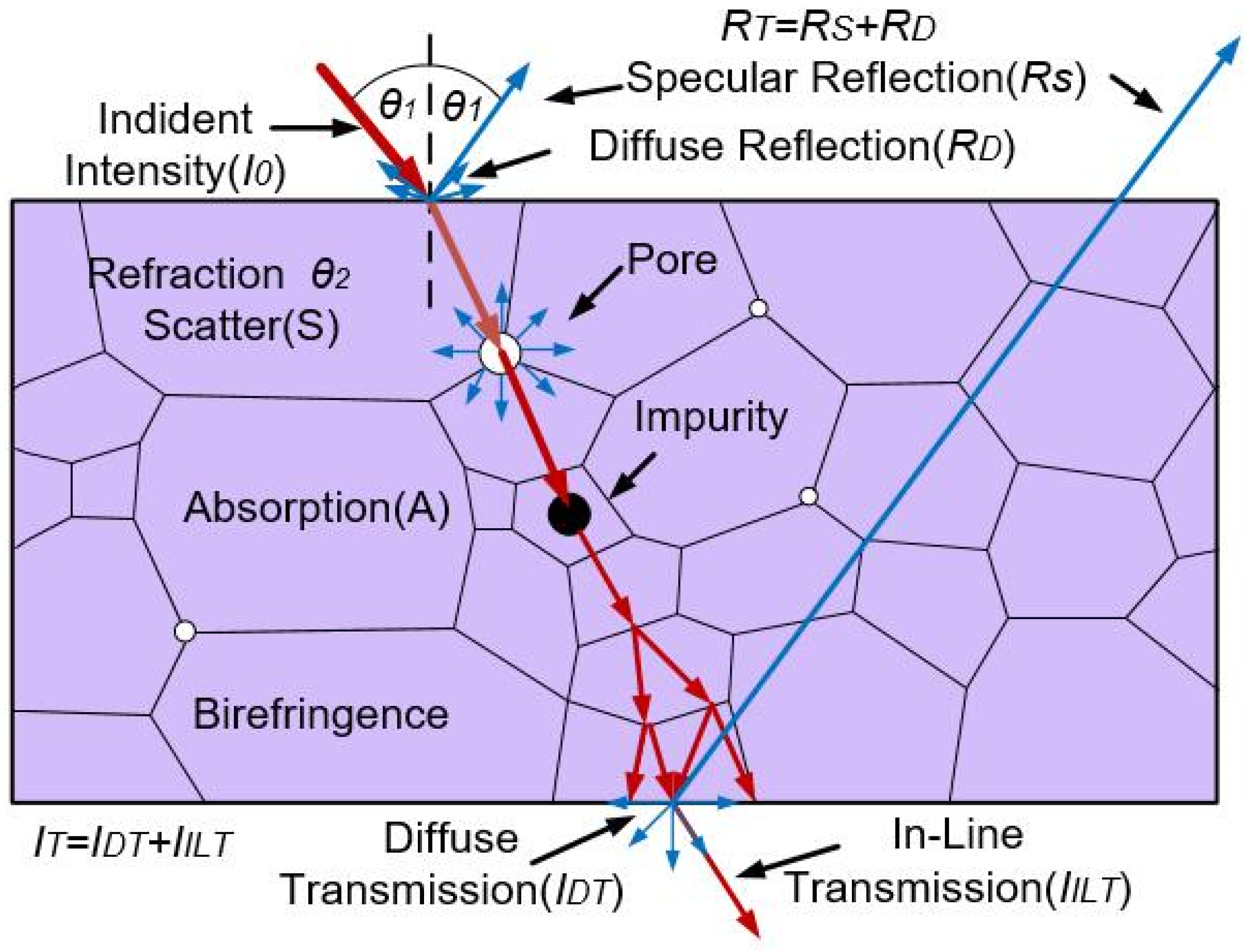
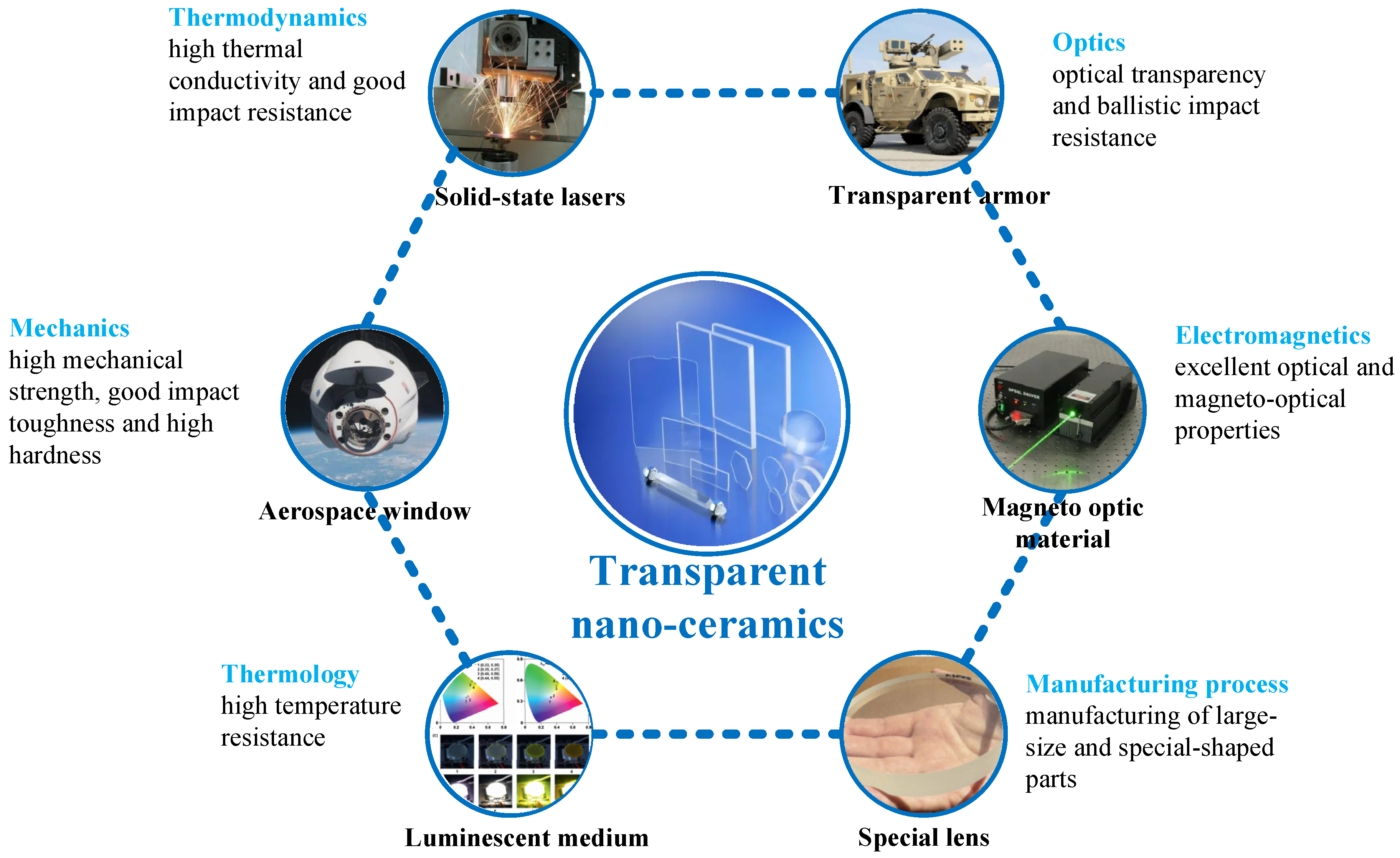


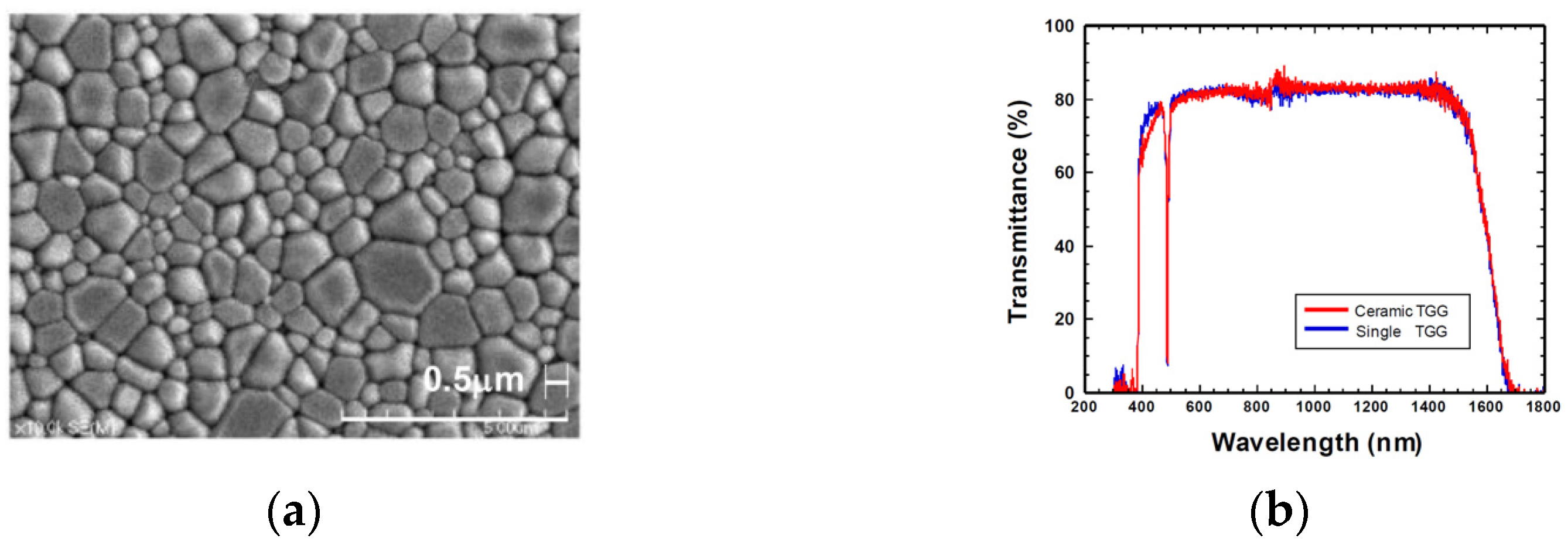


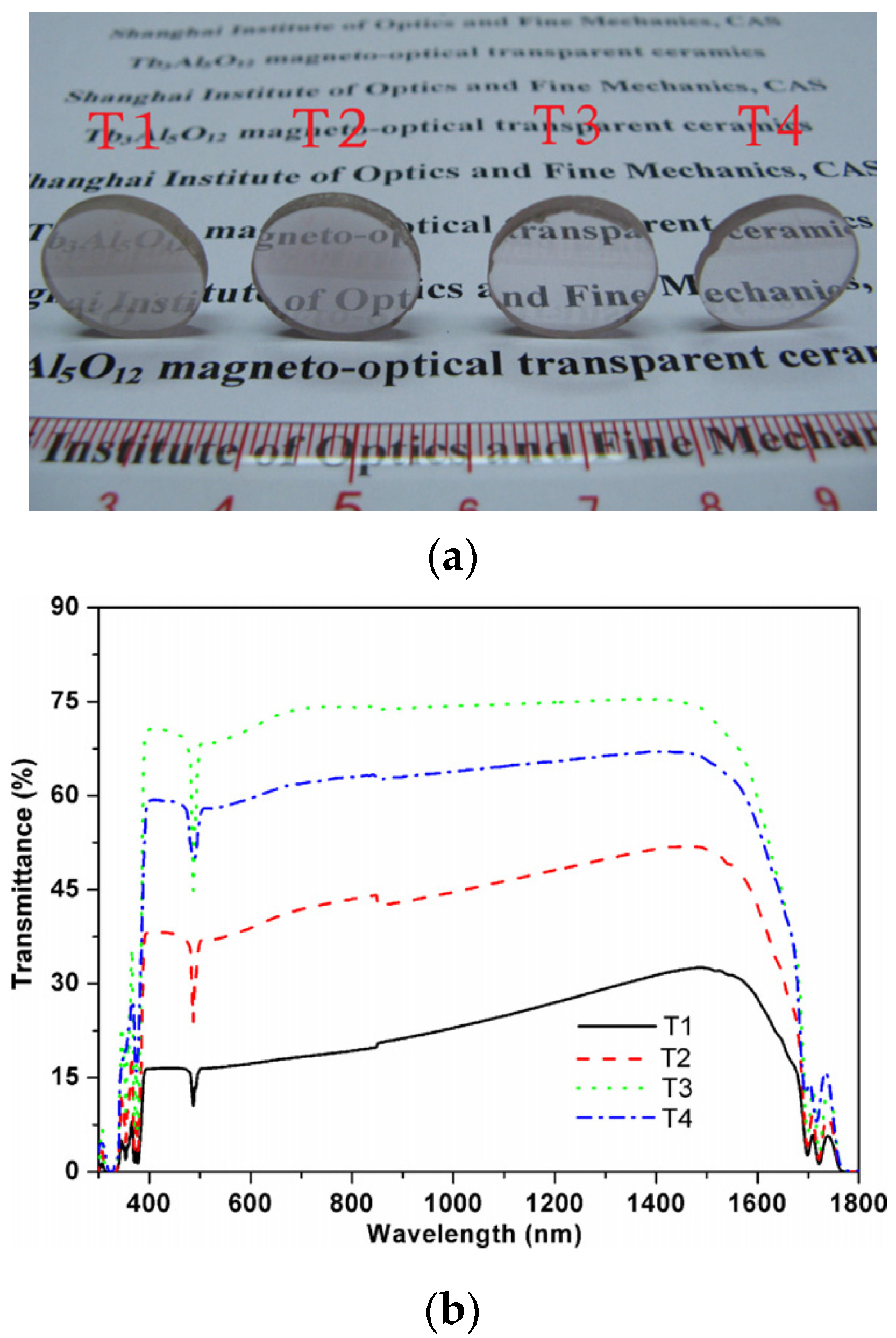
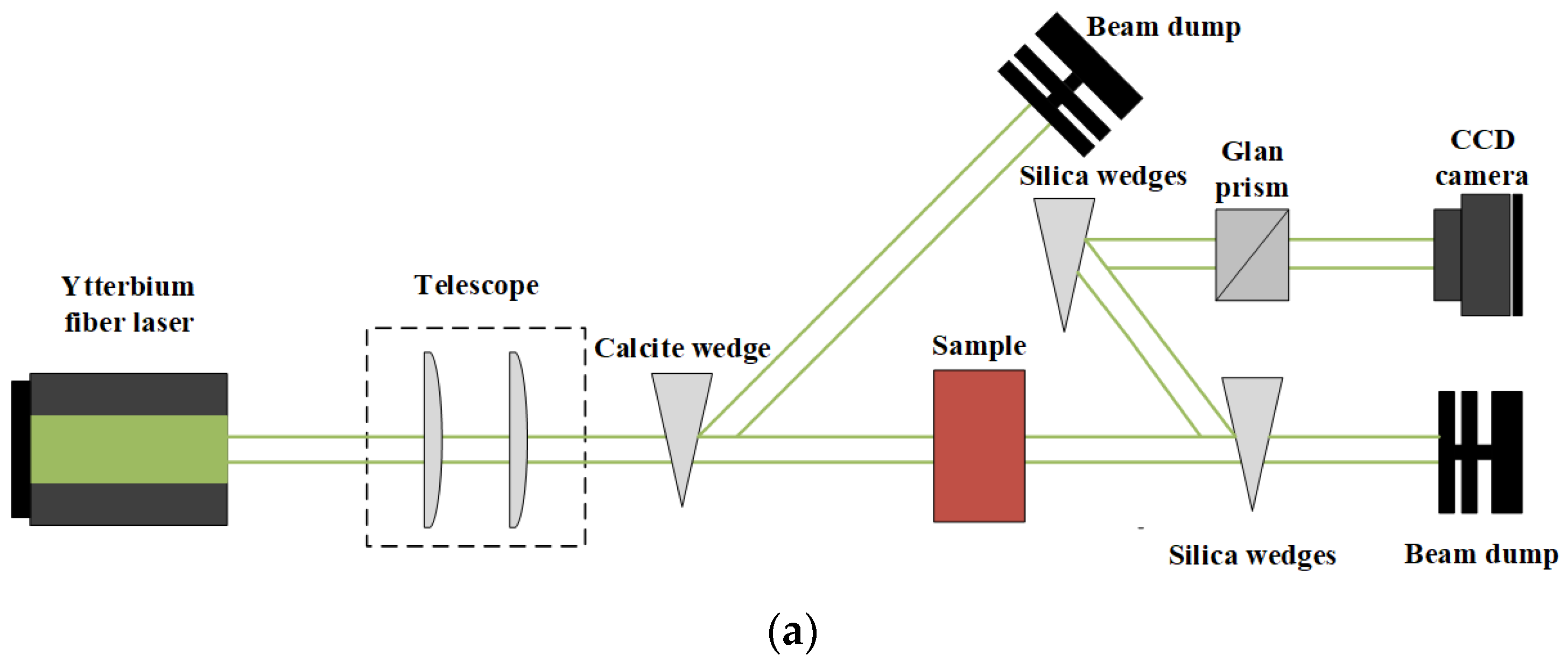
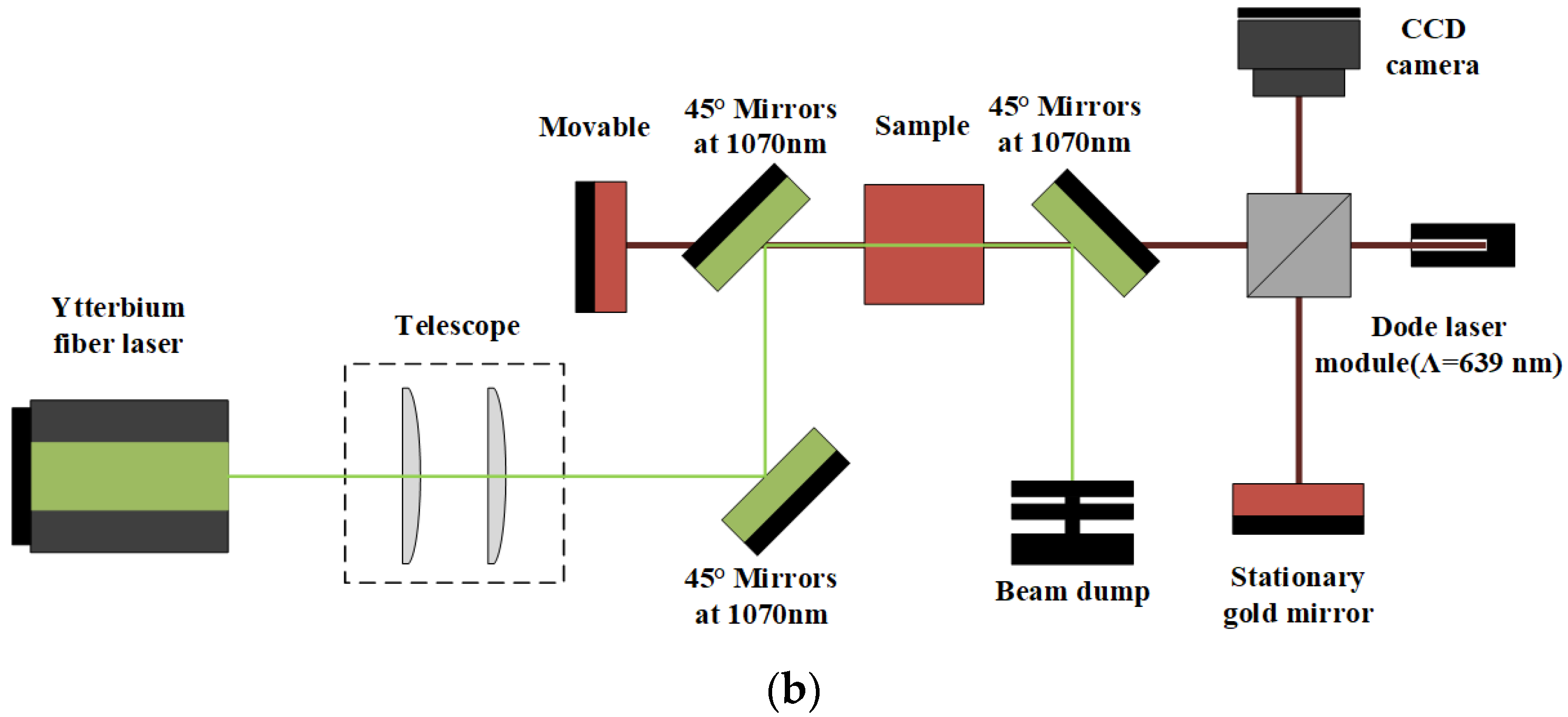
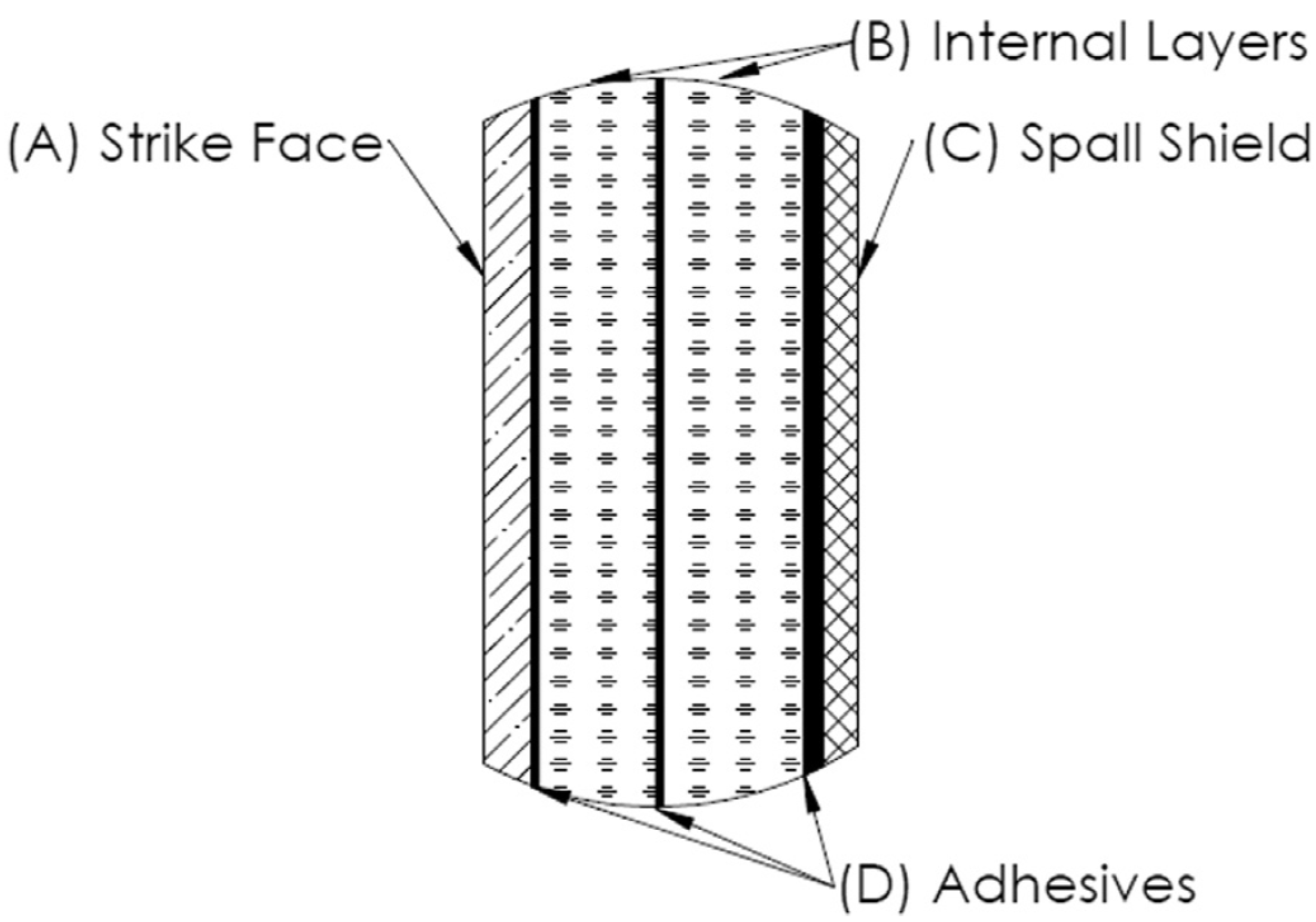
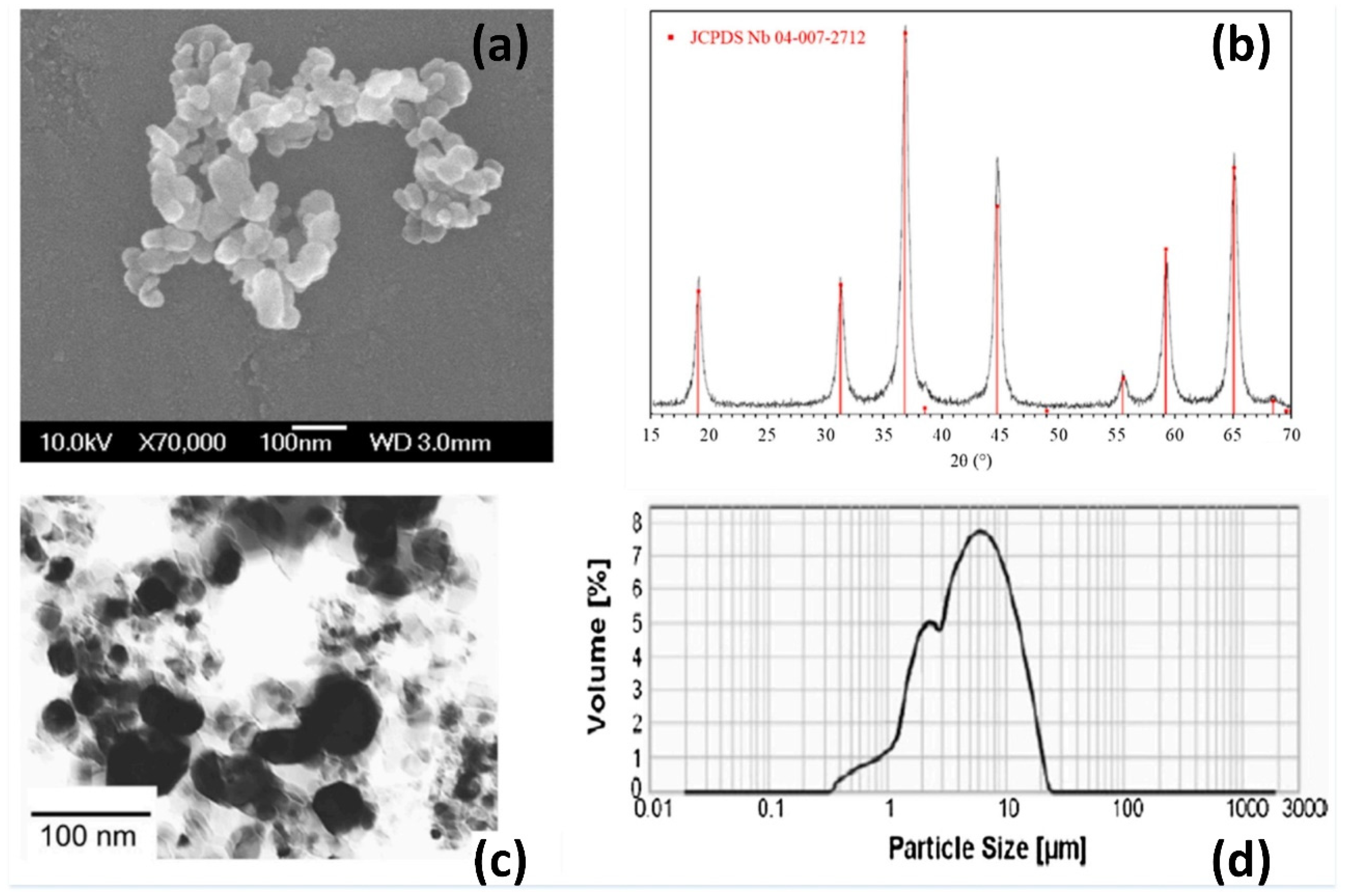

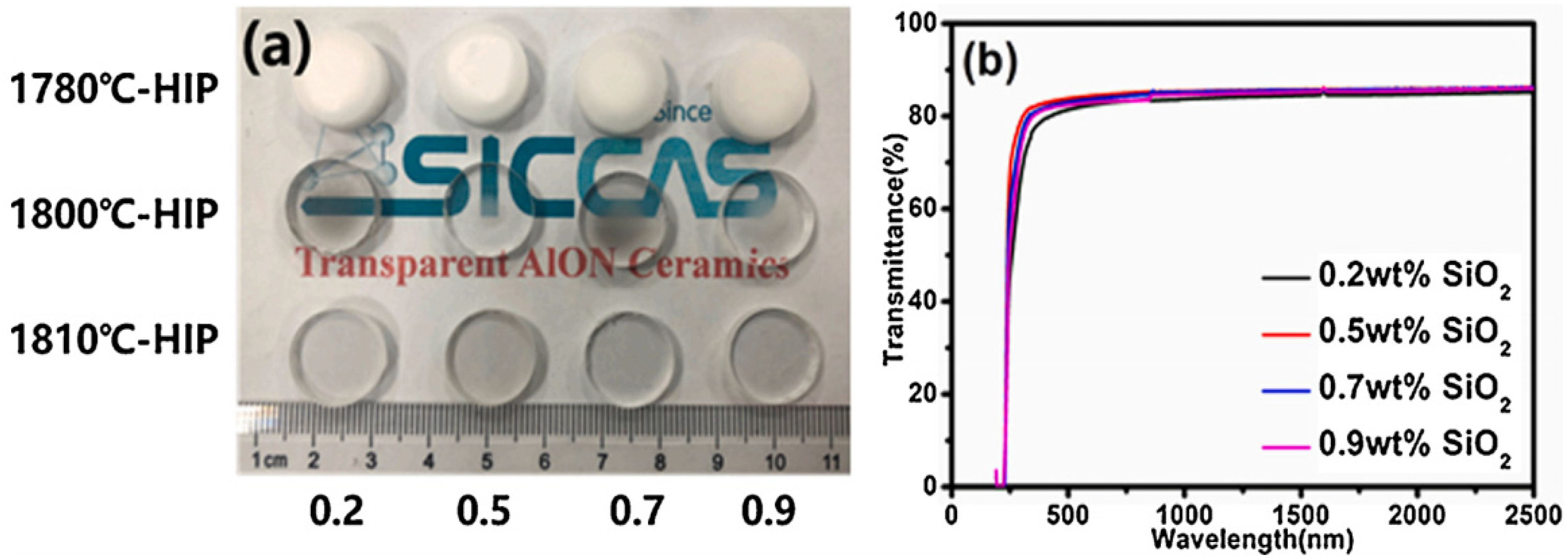
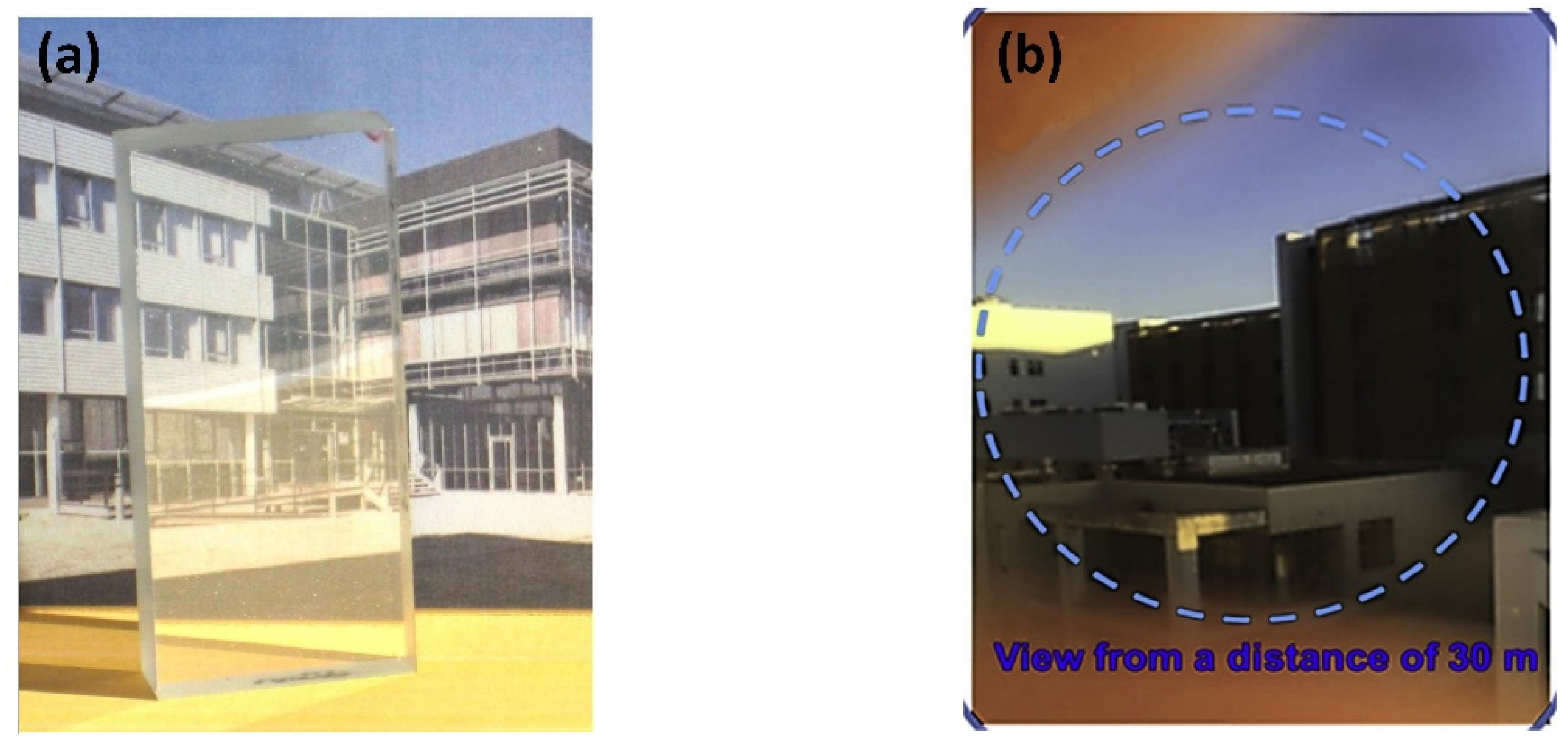
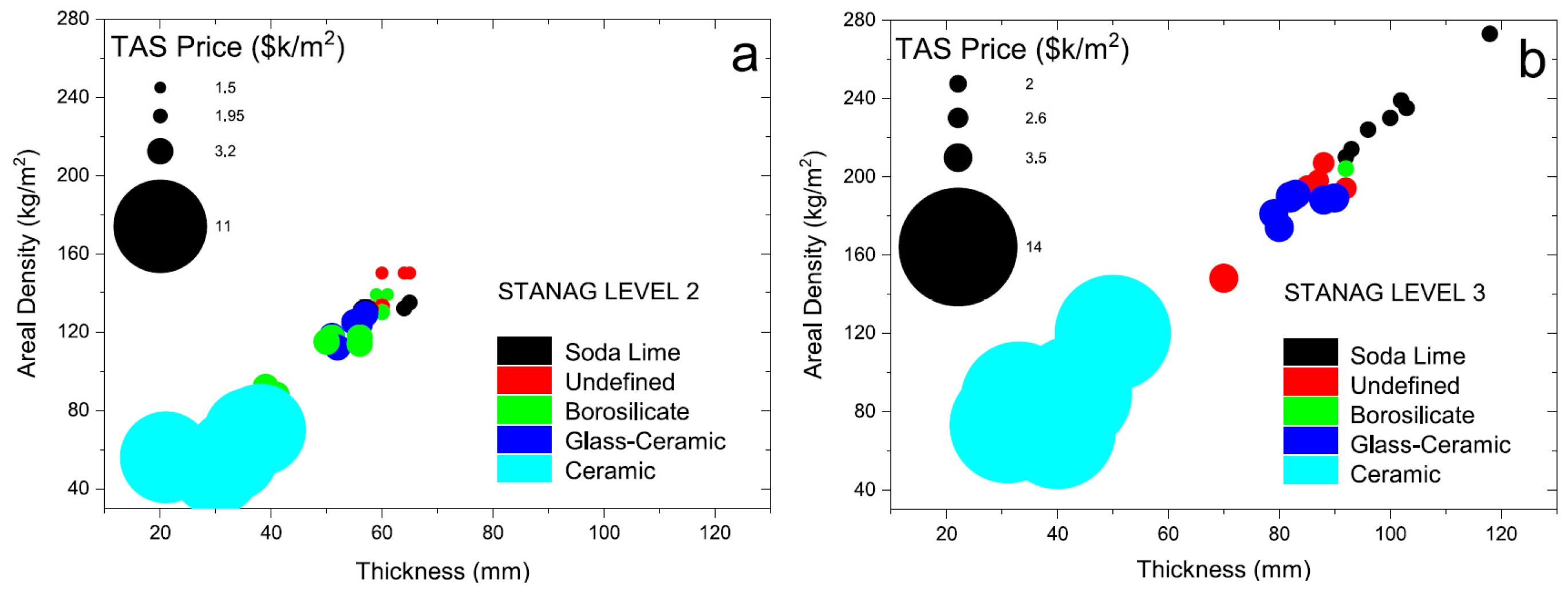

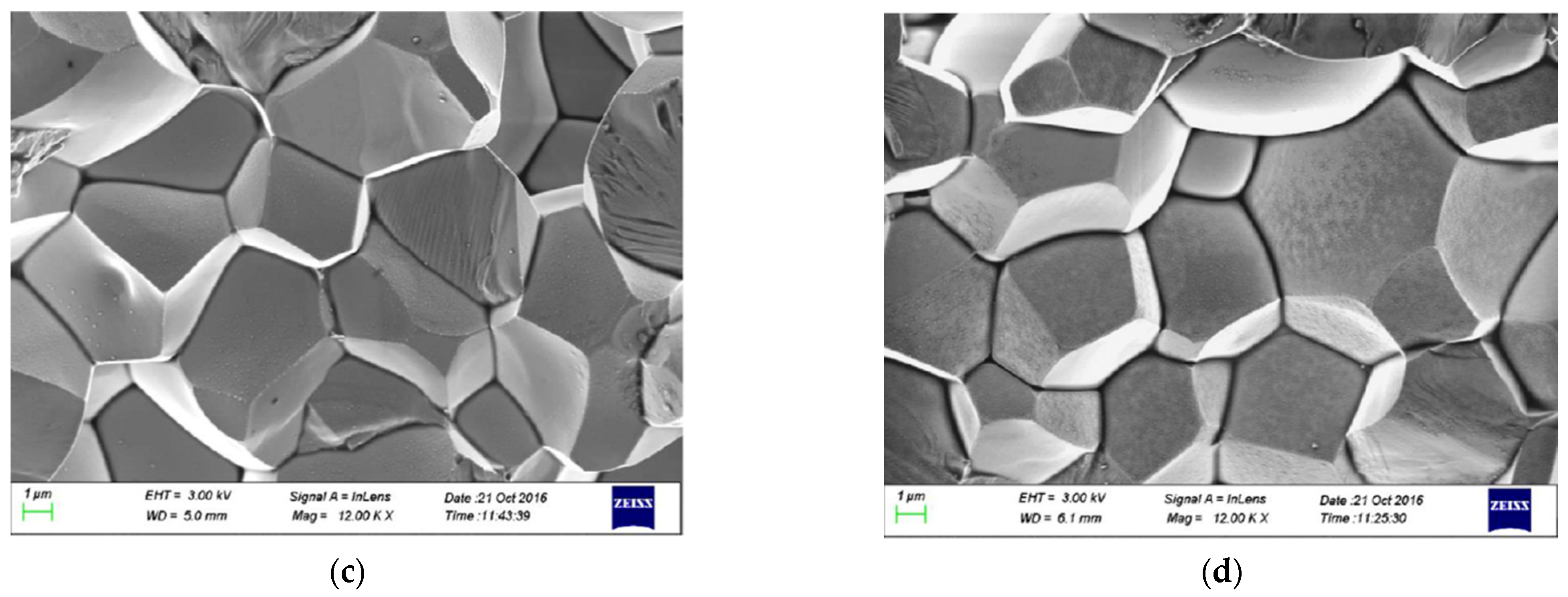
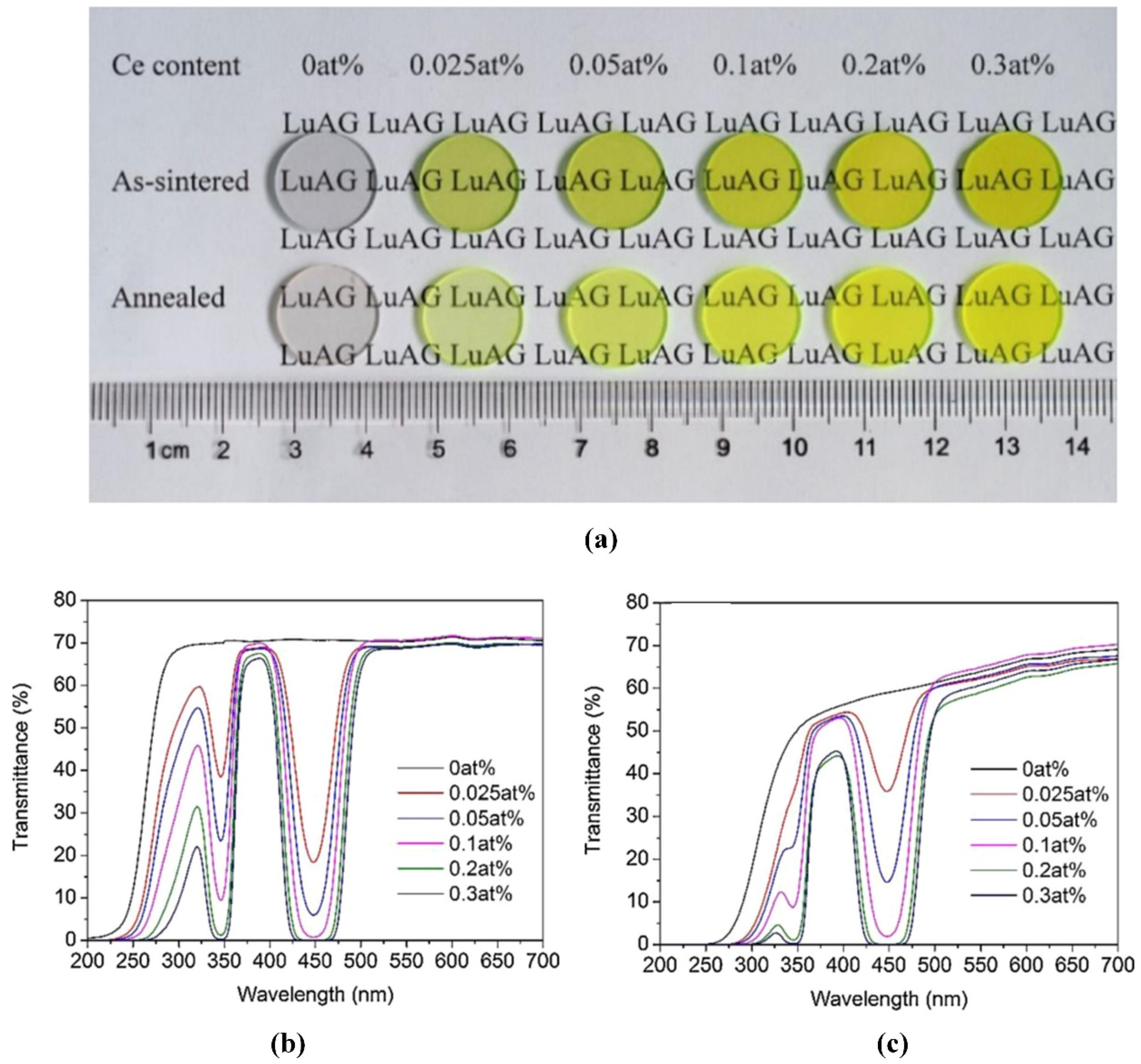
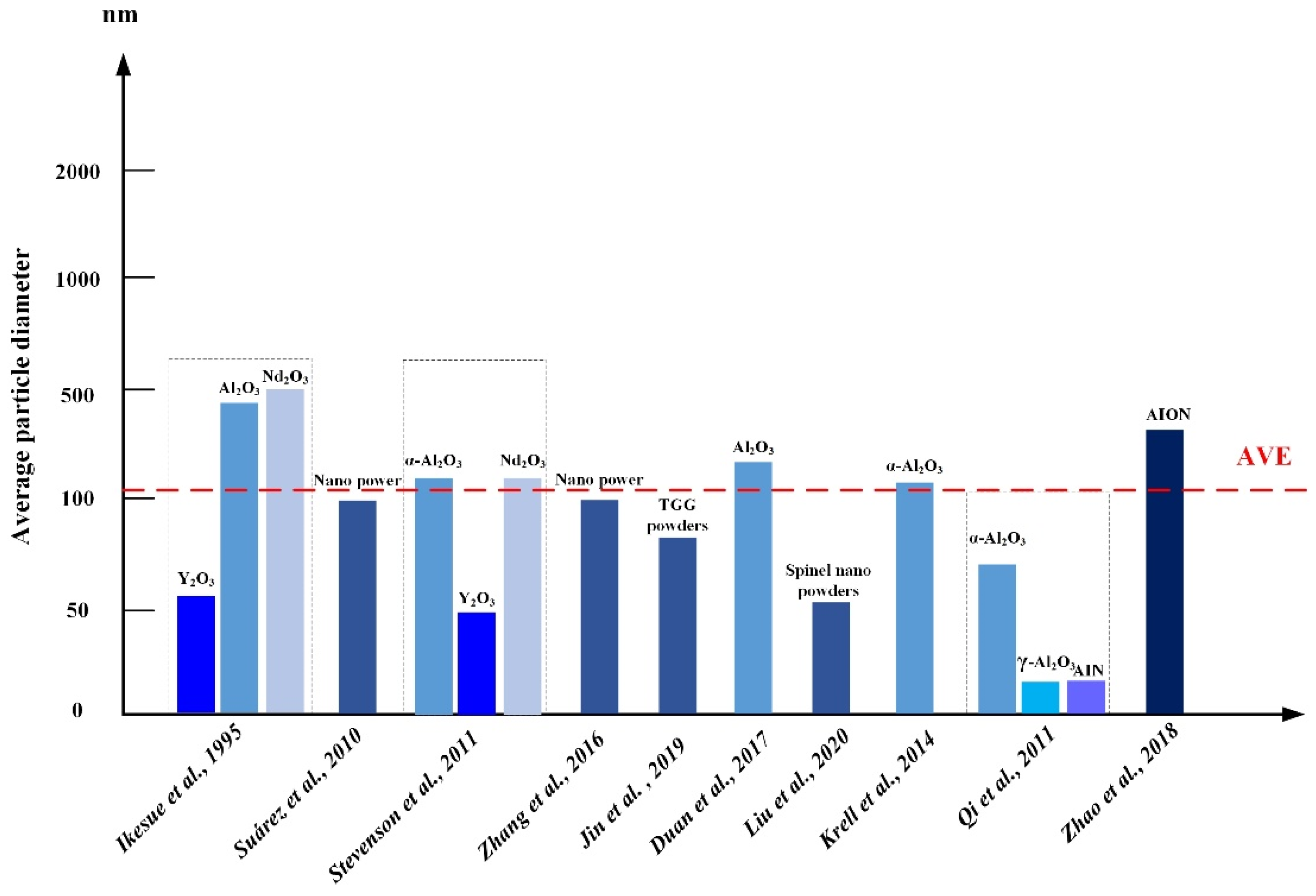
| Doping Type | Year, Powder, and Fabrication | Findings | Performance | Remarks |
|---|---|---|---|---|
| Nd3+-doped | 1995; the starting nano powders include Y2O3 (60 nm), Al2O3 (400 nm), and Nd2O3 (500 nm); solid-state reaction method (Czochralski method). |  The average grain size and relative density of the 1.1 at. % Nd:YAG ceramics were about 50 μm and 99.98%, respectively. | The optical scattering loss of Nd:YAG was about 0.9%/cm. Oscillation threshold of 309 mW and a slope efficiency of 28% [12]. | For the first time, polycrystalline ceramics were successfully used for effective laser cutting. |
| 2002; raw nano powder of oxide of aluminum, yttrium, and neodymium; ball milling -> slip casting -> vacuum sintering -> YAG transparent nano-ceramics. |  The pore volume concentration was 1 ppm, and the average diameter of particles was about 10 μm. The grain boundary width was only about 1 nm [13]. | In laser experiment of Nd:YAG ceramic and single-crystal rods, the output powers of 88 W and 99 W were obtained, respectively [13]. | Compared with single-crystal Nd:YAG, the light-to-light efficiency of Nd:YAG nanocrystalline ceramics needs to be further improved. | |
| 2010; an average particle size of 100 nm by reverse-strike precipitation method; HIP method. | 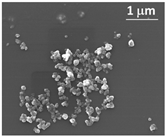 Freeze drying was proven to be an effective method to avoid caking and produced a material nano size distribution with uniform particles [14]. | The infrared transmittance of the sample was 80%, and its emission spectrum was the same as 1 at.% Nd:YAG single crystal [14]. | Nd: YAG nano powder with an average size of about 100 nm was prepared for the first time. | |
| 2021; high-purity powder mixture; cold isostatic pressing. | 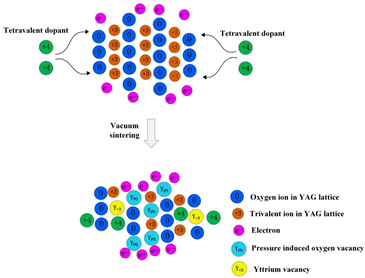 The addition of TEOS promoted the densification of transparent ceramics. | The transmittance of the 0.5 wt.% TEOS sample reached 75% in the near-infrared region [18]. | The densification rate of Nd: YAG transparent ceramics could be adjusted by adding different wt.% TEOS so as to improve its transmittance. | |
| Ho-doped | 2015; the nano powders were made up of near-spherical particles; solid-state reaction involving a pre-calcining stage. |  The transmittance in the infrared region was 82% [21]. | The slope efficiency of laser oscillations in the fabricated Ho:YAG transparent ceramic sample for pumping power was 40% (at 1.85 μm) [21]. | Based on the nano-powders prepared by laser ablation, Ho:YAG optical ceramics with finer particle size were prepared. |
| 2018; uniform ceramic grain; HIP method. | 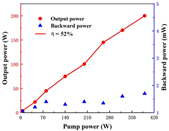 The total absorption spectral width was about 16 nm and suitable for pumping of diode lasers or fiber lasers, and the light-to-light efficiency was 52%. | The in-band pumping method produced a 2117 nm laser with an output power of 24.6 W [22]. | Further development of large-scale, YAG transparent ceramics with low Ho3+ doping concentration is required to alleviate the thermal effect during the lasing process. | |
| Er-doped | 2018; high-purity 0.5 at.% Er3+:YAG powder; SPS+HIP methods. |  At 400 and 1100 nm wavelengths, the on-line transmission values were 75.8% and 82.7%, respectively [25]. | The light–light efficiency of laser was 20%, and the maximum slope efficiency was 31% [25]. | Transmission values of the Er3+: YAG transparent ceramics were lower than that of Er3+:YAG single crystals, which requires further improvement of the fabrication process. |
| Tm-doped | 2010. | 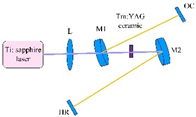 Light-to-light efficiency was 22%. | Under an absorbed pump power of 2.21 W at 785 nm, an output power of up to 860 mW was produced [29]. | Tm:YAG ceramic is a promising laser working medium. Higher power and efficiency can be achieved by using an improved laser cavity and an optimized transmission optical path. |
| Yb-doped | 2008. | 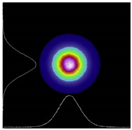 The transverse intensity distribution of the Yb:YAG ceramic laser beam was a Gaussian beam [31]. | The ceramic Yb:YAG laser exhibited a continuous tunability at a maximum output power of 1.6 W [31]. | Except for crystal Yb:YAG investigations, this was the first study of the tunability of ceramic Yb:YAG lasers. |
| Medium | Isolation Ratio@ Laser Power | Isolation Ratio@ Laser Power | Water Cooling |
|---|---|---|---|
| TGG crystal | 30 dB@650 W | 6.5 m@340 W | Optional |
| TGG transparent nano-ceramic | 30 dB@340 W | 6.5 m@340 W | Optional |
| TAG transparent nano-ceramic | 38 dB@300 W | 8 m@300 W | Required |
| Ce: TAG transparent nano-ceramic (0.1 at.%) | 31 dB@300 W | 3.8 m@300 W | Required |
| Year, Authors | Powder and Fabrication | Findings | Performance | Remarks |
|---|---|---|---|---|
| 1970, Haertling et al. [102] | Preparation of optoceramics with a thickness of 1 mm using a two-step hot-pressing method. | The density reached up to 99% of the standard density and the transmittance reached up to 80%. | When the wavelength increased, the light transmission performance also gradually increased to 80%. | The hot-pressing firing method could improve the density of ceramics, but the light transmission performance needed to be improved. |
| 2016, Somwan et al. [103] | Mixture of Bi2O3 and CuO; vibrating grinding and sintering. | After adding mixed oxides, the sintering temperature decreased by nearly 50 °C to 1200 °C. | At 1200 °C, the induced strain of the enhanced electric field reached 0.0079%. | Higher dielectric constants could be obtained at lower sintering temperatures. |
| 2017, Zhang et al. [105] | Mixture of 3% lanthanum, 75% PMN, and 25% PT; two-step hot-pressing method. | As the temperature increased, the half-wave voltage increased from 200 to 400 V. | The electro-optic coefficient increased with an increase in temperature. | The ferroelectric preparation process and transmittance could be controlled by temperature. |
| 2018, Samanta et al. [104] | Mixture of 69 ppm Fe3+ and 78 ppm Nb5+; sol–gel. | Conductivity increased by two orders of magnitude as the sample changed from 100 Hz to 1 MHz. | Conductivity was proportional to frequency. | The conductivity could be controlled by controlling the magnitude of the frequency. |
| 2018, Wang et al. [106] | PMN-PT/CFO thin films; sol–gel spin coating. | The temperature rose from 650 to 730 degrees Celsius; the leakage current decreased from 97.54 to 40.59. | The ferroelectric properties decreased with an increase in the ratio of CFO to PMN-PT and increased with an increase in temperature. | The coupling effect between the ferroelectric phase and the ferromagnetic phase was observed, which will pave the way for the preparation of multifunctional crystals in the future. |
| 2021, Ze et al. [97] | PMN-PT ceramic materials doped with Sm; two-step sintering method. | When the Sm doping amount increased from 0 to 2%, the PMN-PT decreased from 3.15 to 3.05 eV. | When there was Sm doping, it affected the size of the electro-optic coefficient. | The optical power could be controlled by doping Sm. |
| Year, Authors | Powder and Fabrication | Findings | Performance | Remarks |
|---|---|---|---|---|
| 2017, Zhou et al. [115] | 99.9% strontium nitrate hydrate, 99.9% neodymium nitrate hydrate, and 99.9% potassium fluoride hydrate; the chemical precipitation method. | SrF2 nanoparticles with Nd3+ doping concentrations up to 2 mol% kept a single cubic fluoride structure. | The synthesized powder could prepare transparent ceramics with a transmittance of about 80% at 1060 nm. | Nd3+ was successfully introduced into the SrF2 lattice, making it possible to use this material to make transparent ceramics. |
| 2018, Yi et al. [116] | Nd:(Ca0.94Gd0.06)2.06 nano powder; deionized water coprecipitation | As the Nd3+ content increased from 0.5 to 5.0, the measured lifetime dropped sharply from 484.9 μs to 47.8 μs. | The transparent ceramic had high transparency and an almost non-porous microstructure. | The thermal conductivity of Nd:(Ca0.94Gd0.06)F2.06 transparent ceramics was better than that of traditional laser glass, and transparent ceramic is a promising laser material. |
| 2019, Hostaša et al. [118] | Industrial oxide powder, 0.3% Ce: GGAG,Ce0.009Gd2.991Al2Ga3O12 ceramic sample. | At 1250 °C, the formation of the GGAG phase could be observed. This corresponds to the increase in shrinkage observed above 1200 °C, with the optimum at 1430 °C. | TEOS was determined to be the most suitable sintering aid in the tests, providing the highest sample density and clarity. | The optimum amount of sintering aid and the corresponding sintering cycle should be further investigated. |
| 2020, Trofimov et al. [119] | High-purity (99.99%) starting material and 0.5% tetraethyl orthosilicate (TEOS); the coprecipitation method. | The Ce3+ comprehensive RL strength of single crystal increased 1.4 times from RT-450 °C, while polycrystalline ceramics increased 1.9 times from room temperature to 300 °C. | Both single-crystal and polycrystalline ceramics exhibited high optical transparency up to about 2.5 eV. | The LuAG:Ce scintillator could adapt to a wide temperature range and could be applied to many occasions. |
| 2020, Bartosiewicz et al. [120] | Mixure of 4 N-purity Lu2O3, Al2O3, and La2O3 oxides; the μ-PD method using RF induction heating. | With the increase in La content, the main luminescence in the UV region gradually moved from 330 nm to 295 nm. | Lu3Al5O12 produced strong luminescence in the deep ultraviolet spectral range | LuAG: La doping significantly reduced the scintillation afterglow of LuAG: La crystals. Therefore, it is possible to generate new scintillators in the deep ultraviolet range. |
Publisher’s Note: MDPI stays neutral with regard to jurisdictional claims in published maps and institutional affiliations. |
© 2022 by the authors. Licensee MDPI, Basel, Switzerland. This article is an open access article distributed under the terms and conditions of the Creative Commons Attribution (CC BY) license (https://creativecommons.org/licenses/by/4.0/).
Share and Cite
Ming, W.; Jiang, Z.; Luo, G.; Xu, Y.; He, W.; Xie, Z.; Shen, D.; Li, L. Progress in Transparent Nano-Ceramics and Their Potential Applications. Nanomaterials 2022, 12, 1491. https://doi.org/10.3390/nano12091491
Ming W, Jiang Z, Luo G, Xu Y, He W, Xie Z, Shen D, Li L. Progress in Transparent Nano-Ceramics and Their Potential Applications. Nanomaterials. 2022; 12(9):1491. https://doi.org/10.3390/nano12091491
Chicago/Turabian StyleMing, Wuyi, Zhiwen Jiang, Guofu Luo, Yingjie Xu, Wenbin He, Zhuobin Xie, Dili Shen, and Liwei Li. 2022. "Progress in Transparent Nano-Ceramics and Their Potential Applications" Nanomaterials 12, no. 9: 1491. https://doi.org/10.3390/nano12091491
APA StyleMing, W., Jiang, Z., Luo, G., Xu, Y., He, W., Xie, Z., Shen, D., & Li, L. (2022). Progress in Transparent Nano-Ceramics and Their Potential Applications. Nanomaterials, 12(9), 1491. https://doi.org/10.3390/nano12091491







